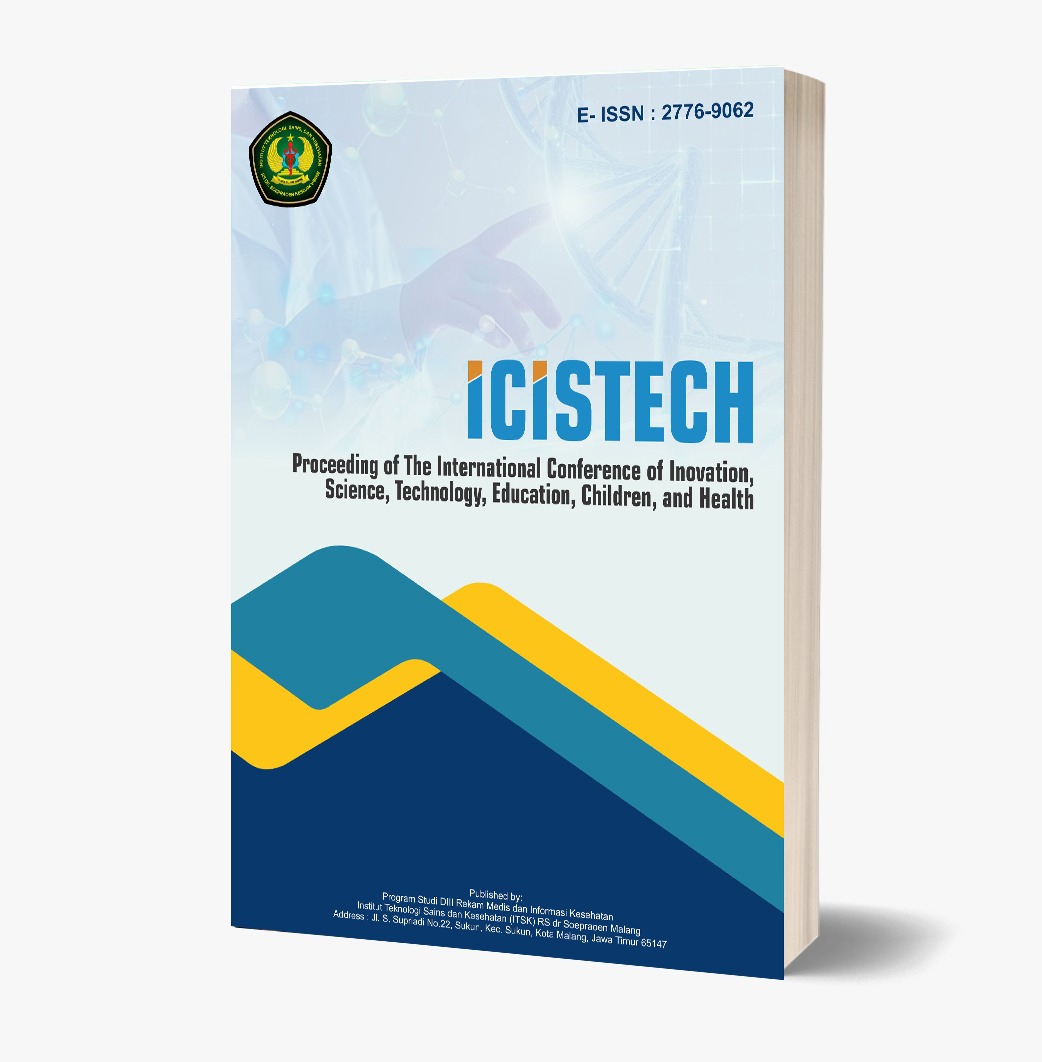Relationship between the Use of Hormonal Contraception and Spotting Incidents in the Sonuo Village Health Center Area
DOI:
https://doi.org/10.62951/icistech.v5i1.184Keywords:
Hormonal Contraception, Spotting, AmenorrheaAbstract
The use of hormonal contraception is a common method used by women of childbearing age to prevent pregnancy. However, this method is often associated with side effects, one of which is spotting or light bleeding outside the menstrual cycle. This study aims to analyze the relationship between the type of hormonal contraception and the incidence of spotting in the Sonuo Village Health Center area. This study used a quantitative design with a cross-sectional approach. The sample consisted of 37 respondents selected by total sampling. Data were collected through questionnaires and analyzed using the chi-square test with the help of SPSS software. The results showed that the majority of respondents used injectable contraception (62.2%), followed by implants (24.3%) and pills (13.5%). Most injectable users experienced spotting (82.6%), while implant users more often experienced amenorrhea (77.8%). The chi-square test showed a significant relationship between the type of hormonal contraception and the incidence of spotting (p-value = 0.000). The conclusion of this study is that the type of hormonal contraception affects the incidence of spotting, where injectables cause spotting more often than other methods. Education about the side effects of hormonal contraception needs to be increased so that users can choose a method that suits their body condition.
References
[1] Ambarita and D. S. Butarbutar, "Prevalence of menstrual disorders in implant acceptors," *JINTAN: Journal of Nursing Science*, vol. 2, no. 1, pp. 8–13, 2022.
[2] H. F. Amran, "Analysis of side effects of using implants contraception method in the work area of Harapan Raya Community Health Center, Pekanbaru," *Medika Husada Journal*, 2019.
[3] H. Putri and S. Arifah, "Comprehensive care for spotting side effects in 3-month injection KB acceptors," 2024.
[4] J. Toar and N. Bawiling, "The relationship between length of use of hormonal contraceptives and the incidence of hypertension in women at Tonsea Lama Health Center," *Journal of Public Health*, vol. 7, no. 2, pp. 281–287, 2022.
[5] L. A. Puti and N. Nikmah, "Overview of hormonal contraceptive use and side effects of hormonal contraceptive use in women of childbearing age," *Indonesian Journal of Midwifery Today*, vol. 1, no. 1, 2021.
[6] M. Megawati and H. Hasrida, "The effect of hormonal contraception on weight gain in women of childbearing age, Ranap Muncang Health Center, Lebak Regency, Banten Province," *Malahayati Health Student Journal*, vol. 5, no. 2, pp. 716–725, 2025, doi: 10.33024/mahesa.v5i2.16701.
[7] Monayo, I. S. Basir, and R. M. Yusuf, "Side effects of hormonal contraceptive use in the Buhu Health Center Work Area, Gorontalo Regency," 2020.
[8] N. A. Pratiwi et al., "Health counseling about family planning and contraceptive devices in Sawah Lebar Village RT 24, Ratu Agung District, Bengkulu City in 2024," *Journal of Real Work of Community Service*, vol. 1, 2024.
[9] N. Khasanah, "The relationship between the use of 3-month injectable contraceptives and spotting incidents in contraceptive acceptors at the Manunggal Jaya Health Center, Nabire Regency," *Journal of Anesthesia*, vol. 1, no. 4, pp. 271–280, 2023, doi: 10.59680/anestesi.v1i4.558.
[10] O. Nency and I. M. Ramadhan, "Comparison of hormonal contraceptive use and duration of menstrual cycle disorders in contraceptive acceptors at TPMB Siti Jaojiah," *Muhammadiyah Nursing Journal*, vol. 8, no. 4, 2023.
[11] R. H. E. Prosfera, E. Norahmawati, and M. Jannah, "The effect of giving papaya seed ethanol extract (Carica papaya L.) on the thickness of the fallopian tube smooth muscle layer of Wistar strain female white rats," *Zona Kebidanan*, vol. 15, no. 1, 2024, doi: 10.37776/zkeb.v15i1.1617.
[12] Raihana, E. Kristiana, and Rafidah, "Relationship between duration of use of 3 months injectable contraceptives and spotting incidents at PMB Bakti Ibu Martapura," *Multidisciplinary Research Journal of Nation*, vol. 1, 2025.
[13] Riandari, Cahyaningrum, and Masruroh, "Spotting and amenorrhea in acceptors of 3-month injectable KB," *Journal of Holistics and Health Sciences*, vol. 6, no. 2, 2024.
[14] S. Alsamsiah, S. Rahayu, and R. Rahmadyanti, "Use of three-month injection contraception with spotting incidence in TPMB, Tempuran District, Karawang Regency, West Java Province," *PPNI West Java Nursing Journal*, 2024.
[15] S. Wahyuni, D. Saryani, and S. Altika, "Relationship between use of 3-month injection contraception with the incidence of weight gain and spotting in contract acceptors in Ngagel Village, Dukuhseti District, Pati Regency in 2022," *Scientific Journal of Obstetrics and Health*, Bakti Utama Pati Health Sciences College, vol. 13, pp. 43–47, 2022.
[16] S. Winarti and N. Azizah, "Acceptors of Depo Medroxyprogesterone Acetate (Depoprovera) Injectable KB with spotting," *Journal of Midwifery*, vol. 14, no. 2, pp. 2580–4774, 2024.
[17] Setyorini and A. D. Lieskusumastuti, "Duration of use of 3-month injection contraception with the incidence of spotting and amenorrhea in PMB Darmiati Ngemplak Boyolali," *Indonesian Midwifery Journal*, vol. 11, pp. 124–133, 2020.
[18] Tusiyani, F. Ayudiah, and Y. Hilinti, "Relationship between WUS knowledge about contraception side effects and parity with the choice of implant contraception at Sumber Harta Public Health Center, Musi Rawas District," *Journal of Andalas Medica*, vol. 2, 2024.
[19] W. A. Nasution, M. Mutmainnah, and Meinarisa, "The relationship of injectable contraceptive use to menstrual cycles and maternal weight gain in the Work Area of Simpang IV Sipin Health Center, Jambi City," *HIJP: Health Information Research Journal*, 2023.
[20] W. L. Arisona, "Relationship between the use of hormonal contraception and the incidence of changes in menstrual patterns in PMB Johana Widijati Widya Lusi Arisona," 2019.
[21] W. Ruari, R. A. Yolandia, and E. P. Noviyani, "Relationship between knowledge, duration of contraception use, type of injectable contraception to menstrual disorders in injectable contraception acceptors at PMB Setiawati Kotawaringin Timur in 2023," *Scientific Research Journal*, 2024.
[22] Y. Puspitasari, T. Nurhanifah, and K. Maharani, "Factors affecting weight gain in acceptors of 2-month injectable KB (Gestin F2) in the Purwoyoso Health Center Work Area, Semarang," *Journal of General Health Science Research*, vol. 2, pp. 82–93, 2024.
[23] Y. Rajadiah, Sunartono, and B. Suryantara, "Changes in menstrual cycle of 1-month injection contraception acceptors Cyclofem and 2-month injection Angestin F2," *Rustida Health Scientific Journal*, vol. 12, pp. 27–37, 2025.
Downloads
Published
How to Cite
Issue
Section
License
Copyright (c) 2025 Proceeding of The International Conference of Inovation, Science, Technology, Education, Children, and Health

This work is licensed under a Creative Commons Attribution-ShareAlike 4.0 International License.













